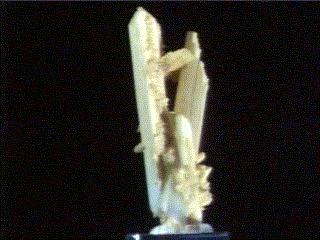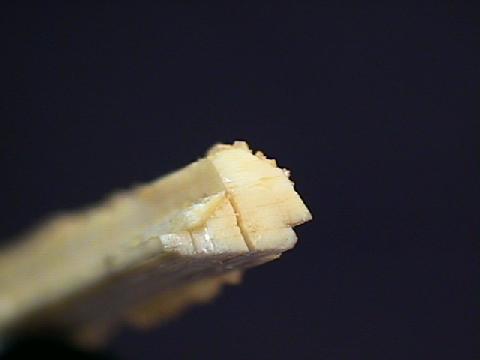 The Mineral
LAUMONTITE
The Mineral
LAUMONTITE
- Chemistry: CaAl2Si4O12-4H2O, Hydrated calcium aluminum silicate
- Class: Silicates
- Subclass: Tectosilicates
- Group: Zeolites
- Uses: mineral specimen and chemical filter
Specimens
Laumontite's structure has a typical zeolitic openness about it that allows large ions and molecules to reside and actually move around inside the overall framework. The structure contains open channels that allow water and large ions to travel into and out of the crystal structure. The size of these channels controls the size of the molecules or ions; therefore, laumontite and other zeolites can act as chemical "sieves".
Zeolites can have a framework, sheet, or chain-like structure. Laumontite's structure is a framework of alumino-silicate tetrahedrons. Laumontite, like other zeolites, commonly forms inside the petrified bubbles (called vesicles) of volcanic rocks that have undergone a small amount of metamorphism. It is often found associated with other zeolites, quartz, gyrolite, calcite, prehnite and apophyllite. These specimens, with such varied associations and forms, can really be fun to collect.
Laumontite is a "must-have" for any zeolite collector, and a real prize for all other mineral collectors as well.
Unfortunately, exposure to light causes a loss of water that can destabilize the crystals and cause them to become powdery.
It actually dehydrates into a new mineral called
PHYSICAL CHARACTERISTICS:
- Color is colorless or white and tinted pink, gray, almond yellow or brown.
- Luster is vitreous to dull on exposure to light.
- Transparency: crystals are transparent to translucent and opaque with exposure to light.
- Crystal System is monoclinic; 2 or m
- Crystal Habits include nearly square prisms terminated by the flat, slanted face of a pinacoid. also massive, fibrous and radiating. Some good penetration twins are found.
- Cleavage is perfect in two directions, forming splinters.
- Fracture is uneven.
- Hardness is less than 4
- Specific Gravity is approximately 2.2+ (very light)
- Streak is white.
- Other Characteristics: crystals are commonly grooved or striated, and cleavage surfaces have a pearly luster.
- Associated Minerals are quartz, calcite, apophyllite, babingtonite, heulandite, natrolite and other zeolites.
- Notable Occurences include Poona, India; Paterson, New Jersey and Pine Creek, California; Iceland and Scotland.
- Best Field Indicators are crystal habit, luster, density, alteration, and associations.





